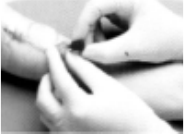
Neonatal Skin Temperature
The goal of neonatal thermal management is to establish an environ-
ment of thermoneutrality in which the metabolic heat production re-
quirement is minimal. Perlstein
14
indicates that both the core and sur-
face temperature of the neonate are required to quantify the rate of
heat loss. The greater the difference between core and surface tem-
peratures, the greater the heat loss from the infant. (This holds only if
vasomotor activity is absent, as is the case for a neonate.) A typical
surface temperature for minimum heat loss is indicated as 36.0-36.5°C
(96.8-97.7°F).
Conventional thermal sensor systems are sensitive to the thermal con-
tact resistance between the surface of the patient and the surface
mounted device. A large thermal resistance will result in inaccurate
surface temperature readings, tending to be on the low side of the ac-
tual surface temperature. This technique requires time for the sensor
to equilibrate and great care in the surface mounting methodology for
accurate measurements. As a consequence, conventional surface
detectors are usually used to monitor one location on the neonate and
multiple site readings are rarely taken.
Infrared thermometry provides a method
for accurate surface temperature mea-
surements on multiple skin surface loca-
tions. The infrared technology has a short
one-second time interval between read-
ings, is essentially independent of user
technique, and has no variable thermal
contact resistance problem. The capabil-
ity of rapid and accurate multi-surface temperature measurements pro-
vides the clinician a new and expanded method for the assessment of
heat loss from the body surface of the neonate.
Wound Management
Increased skin temperature has long been associated with infection,
thus measuring the changes in skin temperature in the area of incision
or trauma when compared to the surrounding tissue provide the neces-
sary quantifiable information for early recognition of such infections,
well before the process has caused any visible skin changes.
Temperature measurement is especially useful for early diagnosis of
postoperative wound infections
1
, those at the IV site, and decubitus
ulcers, for example, and provides for routine quantification of the infec-
tion and subsequent monitoring of the healing process in an objective
manner by the clinical staff.
25


















